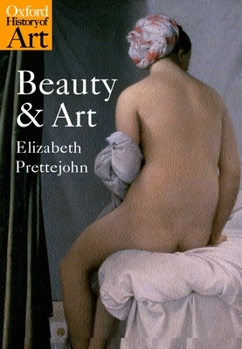Beauty and Art: 1750-2000
Select Format
Select Condition 
Book Overview
What do we mean when we call a work of art beautiful? How have artists responded to changing notions of the beautiful? Which works of art have been called beautiful, and why? Fundamental and intriguing questions to artists and art lovers, but ones that are all too often ignored in
discussions of art today.
Elizabeth Prettejohn argues that we simply cannot afford to ignore these questions. Charting over two hundred years of western art, she...
Format:Paperback
Language:English
ISBN:0192801600
ISBN13:9780192801609
Release Date:July 2005
Publisher:Oxford University Press, USA
Length:224 Pages
Weight:1.05 lbs.
Dimensions:0.6" x 6.6" x 9.4"
Customer Reviews
2 ratings
Recommend buy
Published by Thriftbooks.com User , 15 years ago
This book is approachable, thorough and excellent reading. The book explores the nature of Beauty in a historical perspective from Da Vinci's time to the present.
Beauty: Subjective or Objective..Or Is It Necessary?
Published by Thriftbooks.com User , 16 years ago
Author Prettejohn has written an excellent book, accessible to all, on the relation of beauty to art. She starts with Johann Winckelmann in the 1700s who felt that beauty was important, but not definable. Philosopher Immanuel Kant stated that beauty cannot be objective. Beauty is not in the object, but is in the contemplation of the viewer. We should view art in a state of disinterest, not encumbered by our self interest. In other words anyone in any culture should be able to see the beauty in a work of art. Madame de Stael takes Kant a bit further and says that art's purpose is to elevate the soul. Victor Cousin in the 19th century constructs a scale going from physical to intellectual to moral beauty. Art should not be a close imitation of nature, but should improve on nature. The artist Delacroix writes that the individuality of the artist produces the beautiful. It makes the bridge between the artist's soul and the observer. Academic painter Ingres felt there was no difference between the beauty of art and that of nature. Then we get to Baudelaire who hated realism. To him art should do something more imaginative than servile imitation of nature. From there we move on to modernism and postmodernism where beauty seems no longer necessary to art. Color and form become important. The canvas is a two dimensional medium, and thus considered unsuited to scenic representation. Representational art thus takes a dive, and modern critic Greenberg substitutes the word taste for beauty. Taste, in his opinion is based on consensus. If those in the know agree that a work of art is good, then it is good. Of course Greenberg felt his sense of taste was superior. This is really an excellent introduction to the concept of beauty as applied to visual art. Fortunately, unlike many books on aesthetics, Prettejohn's book contains numerous (127) color prints that help illustrate the concepts being discussed. The book is constantly engrossing, and never pedantic.




